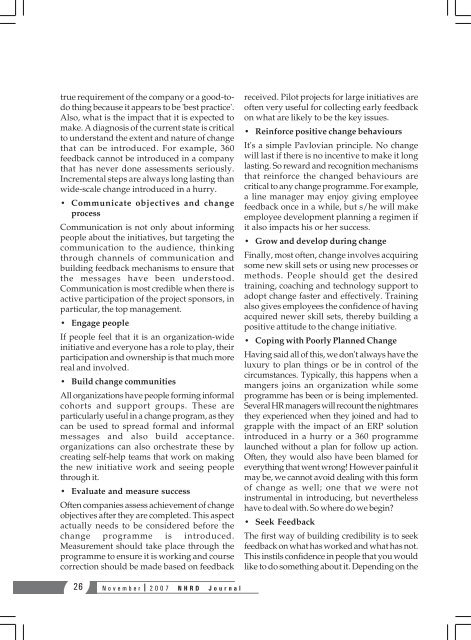NHRD Journal - National HRD Network
NHRD Journal - National HRD Network
NHRD Journal - National HRD Network
You also want an ePaper? Increase the reach of your titles
YUMPU automatically turns print PDFs into web optimized ePapers that Google loves.
true requirement of the company or a good-todo<br />
thing because it appears to be 'best practice'.<br />
Also, what is the impact that it is expected to<br />
make. A diagnosis of the current state is critical<br />
to understand the extent and nature of change<br />
that can be introduced. For example, 360<br />
feedback cannot be introduced in a company<br />
that has never done assessments seriously.<br />
Incremental steps are always long lasting than<br />
wide-scale change introduced in a hurry.<br />
• Communicate objectives and change<br />
process<br />
Communication is not only about informing<br />
people about the initiatives, but targeting the<br />
communication to the audience, thinking<br />
through channels of communication and<br />
building feedback mechanisms to ensure that<br />
the messages have been understood.<br />
Communication is most credible when there is<br />
active participation of the project sponsors, in<br />
particular, the top management.<br />
• Engage people<br />
If people feel that it is an organization-wide<br />
initiative and everyone has a role to play, their<br />
participation and ownership is that much more<br />
real and involved.<br />
• Build change communities<br />
All organizations have people forming informal<br />
cohorts and support groups. These are<br />
particularly useful in a change program, as they<br />
can be used to spread formal and informal<br />
messages and also build acceptance.<br />
organizations can also orchestrate these by<br />
creating self-help teams that work on making<br />
the new initiative work and seeing people<br />
through it.<br />
• Evaluate and measure success<br />
Often companies assess achievement of change<br />
objectives after they are completed. This aspect<br />
actually needs to be considered before the<br />
change programme is introduced.<br />
Measurement should take place through the<br />
programme to ensure it is working and course<br />
correction should be made based on feedback<br />
received. Pilot projects for large initiatives are<br />
often very useful for collecting early feedback<br />
on what are likely to be the key issues.<br />
• Reinforce positive change behaviours<br />
It's a simple Pavlovian principle. No change<br />
will last if there is no incentive to make it long<br />
lasting. So reward and recognition mechanisms<br />
that reinforce the changed behaviours are<br />
critical to any change programme. For example,<br />
a line manager may enjoy giving employee<br />
feedback once in a while, but s/he will make<br />
employee development planning a regimen if<br />
it also impacts his or her success.<br />
• Grow and develop during change<br />
Finally, most often, change involves acquiring<br />
some new skill sets or using new processes or<br />
methods. People should get the desired<br />
training, coaching and technology support to<br />
adopt change faster and effectively. Training<br />
also gives employees the confidence of having<br />
acquired newer skill sets, thereby building a<br />
positive attitude to the change initiative.<br />
• Coping with Poorly Planned Change<br />
Having said all of this, we don't always have the<br />
luxury to plan things or be in control of the<br />
circumstances. Typically, this happens when a<br />
mangers joins an organization while some<br />
programme has been or is being implemented.<br />
Several HR managers will recount the nightmares<br />
they experienced when they joined and had to<br />
grapple with the impact of an ERP solution<br />
introduced in a hurry or a 360 programme<br />
launched without a plan for follow up action.<br />
Often, they would also have been blamed for<br />
everything that went wrong! However painful it<br />
may be, we cannot avoid dealing with this form<br />
of change as well; one that we were not<br />
instrumental in introducing, but nevertheless<br />
have to deal with. So where do we begin?<br />
• Seek Feedback<br />
The first way of building credibility is to seek<br />
feedback on what has worked and what has not.<br />
This instils confidence in people that you would<br />
like to do something about it. Depending on the<br />
26<br />
November 2007 <strong>N<strong>HRD</strong></strong> <strong>Journal</strong>
















